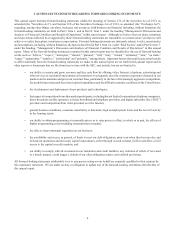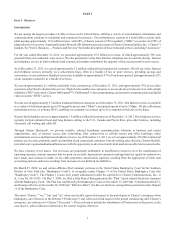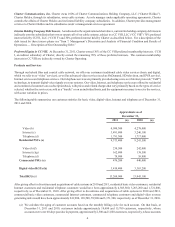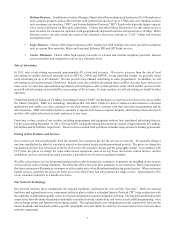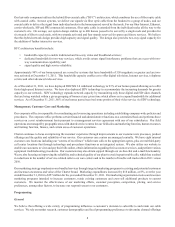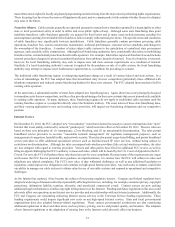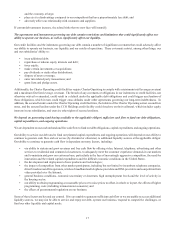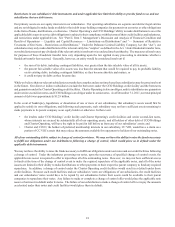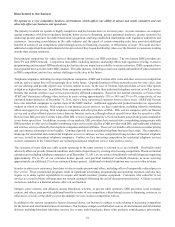Charter 2011 Annual Report Download - page 22
Download and view the complete annual report
Please find page 22 of the 2011 Charter annual report below. You can navigate through the pages in the report by either clicking on the pages listed below, or by using the keyword search tool below to find specific information within the annual report.10
Prior to the scheduled expiration of most franchises, we generally initiate renewal proceedings with the granting authorities. This
process usually takes three years but can take a longer period of time. The Communications Act of 1934, as amended (the
“Communications Act”), which is the primary federal statute regulating interstate communications, provides for an orderly franchise
renewal process in which granting authorities may not unreasonably withhold renewals. In connection with the franchise renewal
process, many governmental authorities require the cable operator to make certain commitments, such as building out certain of
the franchise areas, customer service requirements, and supporting and carrying public access channels. Historically we have
been able to renew our franchises without incurring significant costs, although any particular franchise may not be renewed on
commercially favorable terms or otherwise. Our failure to obtain renewals of our franchises, especially those in the major
metropolitan areas where we have the most customers, could have a material adverse effect on our consolidated financial condition,
results of operations, or our liquidity, including our ability to comply with our debt covenants. See “— Regulation and Legislation
— Video Services — Franchise Matters.”
Competition
We face competition for both residential and commercial customers in the areas of price, service offerings, and service reliability.
We compete with other providers of video, high-speed Internet access, telephone services, and other sources of home entertainment.
We operate in a very competitive business environment, which can adversely affect the results of our business and operations. We
cannot predict the impact on us of broadband services offered by our competitors.
In terms of competition for customers, we view ourselves as a member of the broadband communications industry, which
encompasses multi-channel video for television and related broadband services, such as high-speed Internet, telephone, and other
interactive video services. In the broadband communications industry, our principal competitors for video services is direct
broadcast satellite (“DBS”) and telephone companies. Our principal competitor for high-speed Internet services is DSL service
and high-speed Internet provided by telephone companies. Our principal competitors for telephone services are established
telephone companies, other telephone service providers, and other carriers, including VoIP providers. At this time, we do not
consider other cable operators to be significant competitors in our overall market, as overbuilds are infrequent and geographically
spotty (although in any particular market, a cable operator overbuilder would likely be a significant competitor at the local level).
We could, however, face additional competition from multi-channel video providers if they began distributing video over the
Internet to customers residing outside their current territories.
Our key competitors include:
DBS
Direct broadcast satellite is a significant competitor to cable systems. The two largest DBS providers now serve more than 33
million subscribers nationwide. DBS service allows the subscriber to receive video services directly via satellite using a dish
antenna.
Video compression technology and high powered satellites allow DBS providers to offer more than 285 digital channels from a
single satellite, thereby surpassing the traditional analog cable system. In 2011, major DBS competitors offered a greater variety
of channel packages, and were especially competitive with promotional pricing for more basic services. While we continue to
believe that the initial investment by a DBS customer exceeds that of a cable customer, the initial equipment cost for DBS has
decreased substantially, as the DBS providers have aggressively marketed offers to new customers of incentives for discounted
or free equipment, installation, and multiple units. DBS providers are able to offer service nationwide and are able to establish a
national image and branding with standardized offerings, which together with their ability to avoid franchise fees of up to 5% of
revenues and property tax, leads to greater efficiencies and lower costs in the lower tiers of service. Also, DBS providers are
currently offering more HD programming, including local HD programming. However, we believe that cable-delivered OnDemand
and Subscription OnDemand services, which include HD programming, are superior to DBS service, because cable headends can
provide two-way communication to deliver many titles which customers can access and control independently, whereas DBS
technology can only make available a much smaller number of titles with DVR-like customer control. DBS providers have also
made attempts at deployment of Internet access services via satellite, but those services have been technically constrained and of
limited appeal.
Telephone Companies and Utilities
Telephone companies, including AT&T Inc. (“AT&T”) and Verizon Communications, Inc. ("Verizon"), offer video and other
services in competition with us, and we expect they will increasingly do so in the future. Upgraded portions of these networks
carry two-way video, data services and provide digital voice services similar to ours. In the case of Verizon, high-speed data


